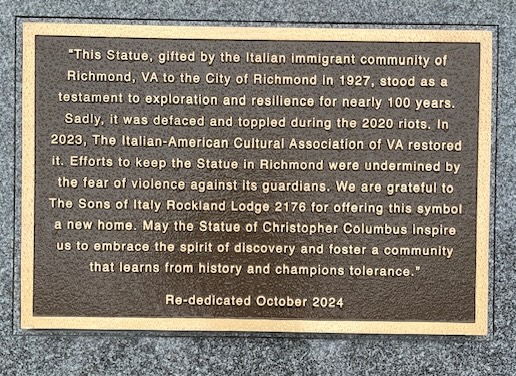A statue of Christopher Columbus that once sat prominently near the entrance of Byrd Park in Richmond for nearly a century has a new home in New York.
In 2020, after the death of George Floyd in Minneapolis led to Black Lives Matter riots across the country, Columbus’ statue was defaced, torn down, and thrown into Fountain Lake by protestors. During this tumultuous time, many Confederate statues were removed around the country, including from Monument Avenue.
Members of Richmond’s Italian American Cultural Association (IACA) acquired the statue and funded its restoration. Now the statue has made a journey of its own, traveling hundreds of miles north to its new home in New York.
In a 2023 column in The Catholic Virginian, Bishop Barry C. Knestout noted that before Columbus was ever a sailor, he was a Catholic. His faith fueled his legendary voyages, and in turn, Catholicism was spread far and wide. While Bishop Knestout acknowledged the controversy surrounding Columbus, he respects the statue not solely for the figure it represents but for the community that built it.
“It saddens me that a statue which was meant to express patriotism and the connection of the Italian community with our nation would be torn down nearly a hundred years later,” he wrote. “It was a symbol of patriotism and participation of a marginalized group, most of whom were Catholic, but is now seen as offensive to marginalized groups.”
Italian Americans were much maligned in the 19th and 20th centuries, both for being foreign and for being Catholic. In the 1920s, Italian Americans in Richmond commissioned artist Ferruccio Legnaioli to create a statue of Columbus as a symbol of their pride in Italy and in America.
However, the political climate of the time worked against them. The Ku Klux Klan, which held significant sway at the time, pressured committee members to vote against the proposal. Eventually, the statue was approved, but was denied a coveted spot on Monument Avenue.
“Traditionalists argued it would be a sacrilege for Columbus, a foreigner synonymous with Catholicism, to stand anywhere, much less on ground revered for Confederate statues,” stated John Corritone, member of the IACA and parishioner of St. Michael the Archangel, Glen Allen. Instead, it was relegated to the Boulevard, where it stood for 93 years.
Corritone was the driving force behind the effort to save the statue. He explained that IACA members maintained the grounds around the statue in Richmond out of respect for the Italian immigrant community. He also said IACA’s goal is to “connect with passion to preserve and promote Italian culture for current and future generations.”

It took two and a half years for IACA to wade through bureaucratic channels and be granted ownership of the statue, but their work was far from over. The statue was badly damaged and covered in slime, graffiti, and trash. This required significant repairs and restoration. IACA raised about $5,000 through member donations and various fundraisers.
IACA didn’t have to look far for someone to restore the statue. One of its own members, Frank Papik, also a parishioner of St. Gabriel, Chesterfield, has four decades of welding and metalwork experience under his belt and offered his services for free. He spent dozens of hours sandblasting thick layers of debris and repairing cracks in the statue over a three-month period.
IACA then turned to another member, Paul DiPasquale, to complete the process of staining and sealing the statue. DiPasquale is a well-known Italian sculptor and Richmond resident who created the Arthur Ashe monument that stands on Monument Avenue. Papik and DiPasquale’s work was completed in August 2023.

“I just wanted to leave my footprint on something, and I did,” said Papik. “We put our heart and soul into that thing, and when we got done, it looked like the day it was made.”
The next step was finding the statue a home. IACA first approached various historical sites and museums in Virginia, which declined to house the controversial artwork. IACA then contacted the Italian and Spanish embassies in Washington, D.C. but were unsuccessful there, as well.
History seemed to be repeating itself until a chance encounter Papik had with a former union colleague in New York. This conversation led him to the Rockland Lodge order of the Sons of Italy in Blauvelt, New York. The fraternal organization for those of Italian origin was interested in housing the statue.
Corritone, Papik, and other IACA members traveled to New York to meet with them. After seeing the grounds, they all agreed that this was where Columbus belonged.
The Columbus statue was planted in its new world Sept. 29 with a rededication ceremony at the lodge. IACA and Sons of Liberty members, clergy, politicians, police officers, Knights of Columbus, community organizations, and many others were in attendance.
“Columbus represents the American legacy in this country, where all of us as immigrants or descendants of immigrants arrived in America in search of a better life and the freedoms that America provides,” said Corritone. “It is still possible today in America for that life to be achieved by those who are in search of it.”

